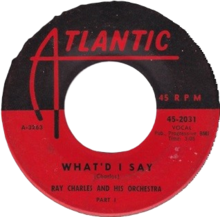| "What'd I Say" | ||||
|---|---|---|---|---|
 | ||||
| Single by Ray Charles | ||||
| from the album What'd I Say | ||||
| B-side | "What'd I Say, Pt. 2" | |||
| Released | June 1959 | |||
| Recorded | February 18, 1959 | |||
| Genre | ||||
| Length | 5:10 (Monaural album) 3:05 (Part 1) 1:59 (Part 2) 6:27 (Stereo album) | |||
| Label | Atlantic | |||
| Songwriter(s) | Ray Charles | |||
| Producer(s) | Jerry Wexler | |||
| Ray Charles singles chronology | ||||
| ||||
| "What'd I Say" | ||||
|---|---|---|---|---|
| Single by Jerry Lee Lewis | ||||
| from the album Jerry Lee's Greatest! | ||||
| B-side | "Livin' Lovin' Wreck" | |||
| Released | February 1961 | |||
| Recorded | 1961 | |||
| Studio | Phillips Recording Service, Nashville, Tennessee[2] | |||
| Genre | Pop | |||
| Label | Sun | |||
| Songwriter(s) | Ray Charles | |||
| Jerry Lee Lewis singles chronology | ||||
| ||||
| "What'd I Say" | ||||
|---|---|---|---|---|
| Single by Bobby Darin | ||||
| from the album Bobby Darin Sings Ray Charles | ||||
| Released | March 1962 | |||
| Recorded | 1961 | |||
| Genre | Pop | |||
| Length | 2:15 (Part 1) 1:43 (Part 2) | |||
| Label | Atco | |||
| Songwriter(s) | Ray Charles | |||
| Producer(s) | Jimmie Haskell | |||
| Bobby Darin singles chronology | ||||
| ||||
"What'd I Say" (or "What I Say") is an American rhythm and blues song by Ray Charles, released in 1959. As a single divided into two parts, it was one of the first soul songs. The composition was improvised one evening late in 1958 when Charles, his orchestra, and backup singers had played their entire set list at a show and still had time left; the response from many audiences was so enthusiastic that Charles announced to his producer that he was going to record it.
After his run of R&B hits, this song finally broke Charles into mainstream pop music and itself sparked a new subgenre of R&B titled soul, finally putting together all the elements that Charles had been creating since he recorded "I Got a Woman" in 1954. The gospel and rhumba influences combined with the sexual innuendo in the song made it not only widely popular but very controversial to both white and black audiences. It earned Ray Charles his first gold record and has been one of the most influential songs in R&B and rock and roll history. For the rest of his career, Charles closed every concert with the song. It was added to the National Recording Registry in 2002 and appeared in the 2003 and 2021 versions of Rolling Stone's "The 500 Greatest Songs of All Time" list: at number 10 in 2003 and at number 80 in 2021.
- ^ Campbell, Michael (2018). Popular Music in America: The Beat Goes On (5th ed.). Cengage Learning. p. 188. ISBN 978-1337560375.
- ^ Snoddy, Glen (1972). "Nashville, The Recording Center" (PDF). Country Music Who's Who. Record World. Retrieved 10 May 2024.